A RAW file (standing for ‘raw’) is a file generated by a digital camera and which contains all the data generated by the sensor, raw processing, plus additional information depending on the make and model of the device.
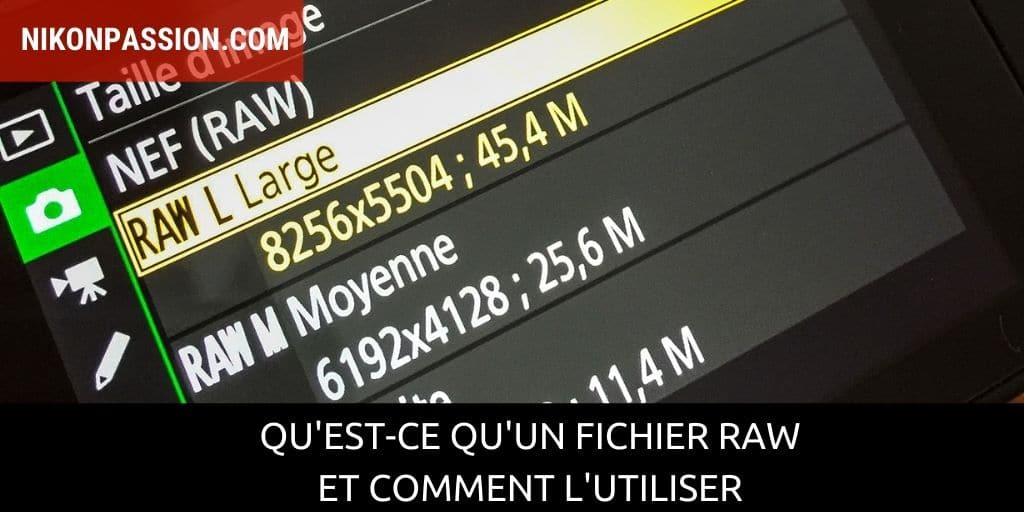
What is a RAW file?
The RAW file format is used by expert and professional photographers to optimize their images and have more processing possibilities in dedicated software than with JPG (learn more about the nature of this format).
In addition to the data from the sensor, the RAW file contains all kinds of information, including information specific to the body (make, model, type of lens, etc.) as well as the shooting data (exposure settings , speed, aperture, etc.) or EXIF data. The RAW file is to digital photography what negative film is to analog photography.
Without trying to complicate the subject, know that a RAW file encodes the data on 12, 14 or 16 bits depending on the model while a JPG file does it on 8 bits. Now, the greater the number of bits used for encoding, the greater the richness of colors and the greater the processing latitude. Thus, for example, recovering details in high or low lights burnt and / or blocked remains possible in RAW while in JPG, with 8 bits, the camera has already processed the photo, it is no longer possible or so few recover these areas.
The information relating to the image is the raw data coming from the sensor, data which can undergo a first processing by the internal electronics of the box according to the brands.
However, this data does not constitute an image file in the sense that it is raw data: the RAW file is not readable as an image file, it is necessary to use specialized software which knows how to interpret the RAW data and makes it possible to generate a file that can be used in a pivot format like JPG most of the time.
How to view RAW files
Windows 10 and MacOS can recognize RAW files and display them (after installing a codec or driver if necessary). Some generic software can do this too, but it is usually not possible to develop RAW files using such general software.
You must use software for developing and processing RAW files (for example Adobe Lightroom or Nikon NX Studio); sometimes called a derawtiseur.
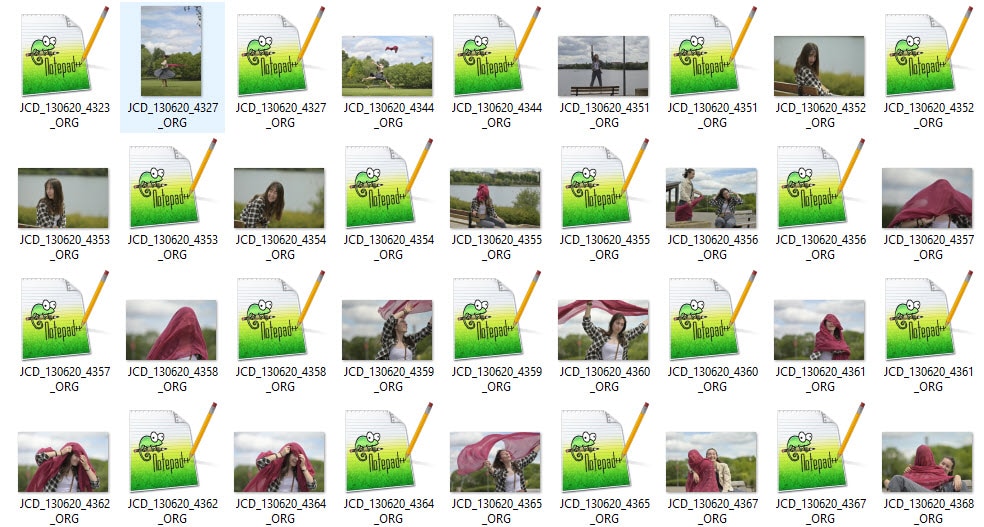
Nikon RAW (Nikon Electronic Format) files listed in Windows Explorer
Examples of software for processing RAW files
Here are some examples of popular RAW file processing software:
- Adobe Photoshop CC (and previous versions),
- Adobe Photoshop Elements,
- Adobe Lightroom Classic (and previous versions),
- Nikon NX Studio,
- Apple Photos,
- Darktable,
- Capture One Pro,
- Luminar AI,
- …
Some image processing software requires an add-on to be able to read and process RAW files, such as Adobe software that uses the Camera RAW module. This module is installed by default with the software mentioned above. The free software GIMP requires the UFRaw plugin (see the photo software choice guide).
Why use the RAW format?
Unlike the JPG format, the RAW format provides all the information captured by the sensor.
The JPG file is generated by the camera from the raw data of the sensor and after application of the shooting parameters chosen by the user. Once the JPG file produced by the camera has been saved on the card, it is no longer possible to intervene on the initial image.
Image processing software can handle JPG formats satisfactorily, but the RAW format is the only one that offers maximum processing capabilities.

Original image in RAW format converted to non-reprocessed JPG
The other advantage of the RAW format is that its processing is non-destructive: it is possible to modify the rendering of the image in the software, to produce a JPG version and to go back if necessary to produce another image on the base of the same file, with a different rendering. These steps do not alter the content of the RAW.
These capabilities make the RAW format a very flexible format which offers an infinite possibility of processing with a few simple notions. Those who want to go further in photo processing and retouching will find the RAW format the ideal file type to express their creativity.

What is RAW file: original RAW image converted to JPG after custom processing
Better image quality after processing
If you shoot in JPG and use image processing software to make enhancements to your photos, you create compressed files every time you save. It is characteristic of the JPG format to compress the image before saving it, and this compression occurs during each save.
After several successive backups of the same image, the overall quality of the image will be greatly degraded. With the RAW format all the recordings are done in a non-destructive way, you can modify and save your images as often as you want, they do not undergo any degradation (if your RAW processing software applies a non-destructive processing).
Better control of image quality
When using the JPG format, the body processor decides to apply shooting settings such as white balance, exposure, tone correction, and create the JPG file. You can no longer modify these settings once the JPG image has been saved.
With the RAW format, it is during image processing on your computer that you choose to apply one or the other of the values for each of the settings. This gives you a lot more flexibility and possibilities to get the image you want. You can create multiple interpretations of the same file in order to compare them and choose the one you like the most.
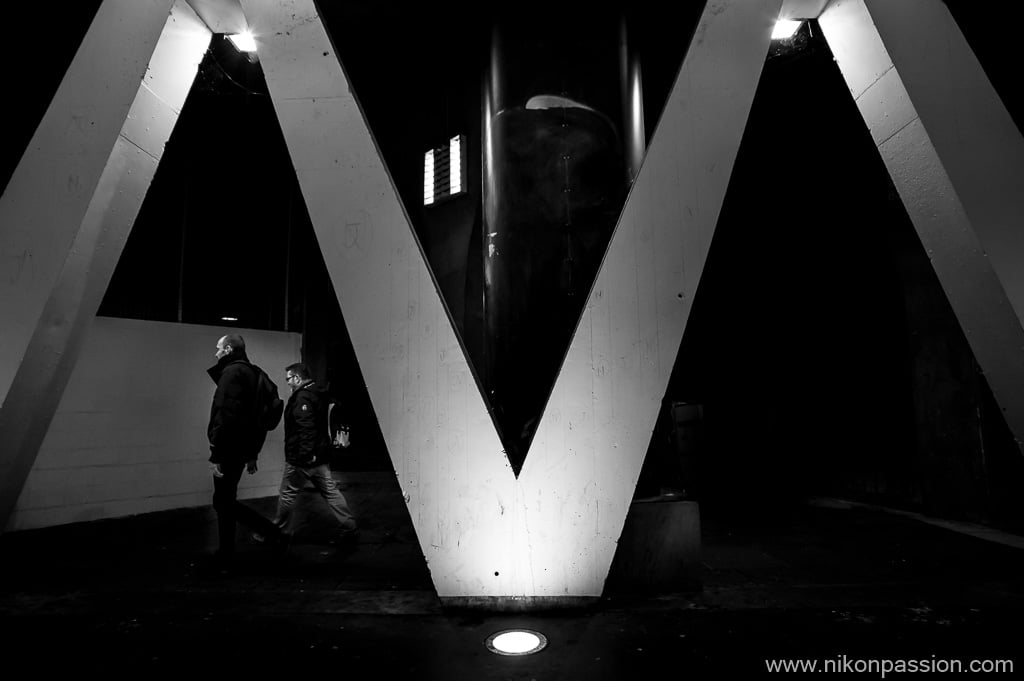
What is RAW file: different interpretation of the above RAW file
Possibilities of successive treatments
With the RAW format, and because its processing is non-destructive, you can work on the same image several times over time. So if your tastes change, or if you go for a single treatment for a series of photos, then you can go back to the first images in the series and apply the treatment you just developed for the last ones. You guarantee the homogeneity of the series.
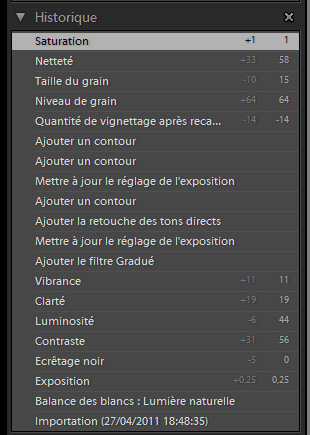
Different stages of processing a RAW file in Lightroom with the possibility of non-destructive rollback
Disadvantages of RAW format
Although it has a lot of advantages, the RAW format has a few disadvantages.
The size of a RAW file is larger than that of the JPG file for the same image. You can therefore store fewer photos on the same memory card, and this imposes additional constraints in terms of disk space on your computer.
Depending on the camera, it takes longer to save RAW files to the card during shooting, resulting in a lower frame rate in burst mode.
A RAW file cannot be shared or printed directly before processing. To send it by email or post it on a website, you must process it and create a JPG file. The same is true for obtaining prints via a digital lab or an online lab.
To know more …
If you want to know more about the RAW format and how to use it, I recommend these additional articles:
A question about what is a RAW file and how to use it? The comments are there for that!
A RAW file (standing for ‘raw’) is a file generated by a digital camera and which contains all the data generated by the sensor, raw processing, plus additional information depending on the make and model of the device.

What is a RAW file?
The RAW file format is used by expert and professional photographers to optimize their images and have more processing possibilities in dedicated software than with JPG (learn more about the nature of this format).
In addition to the data from the sensor, the RAW file contains all kinds of information, including information specific to the body (make, model, type of lens, etc.) as well as the shooting data (exposure settings , speed, aperture, etc.) or EXIF data. The RAW file is to digital photography what negative film is to analog photography.
Without trying to complicate the subject, know that a RAW file encodes the data on 12, 14 or 16 bits depending on the model while a JPG file does it on 8 bits. Now, the greater the number of bits used for encoding, the greater the richness of colors and the greater the processing latitude. Thus, for example, recovering details in high or low lights burnt and / or blocked remains possible in RAW while in JPG, with 8 bits, the camera has already processed the photo, it is no longer possible or so few recover these areas.
The information relating to the image is the raw data coming from the sensor, data which can undergo a first processing by the internal electronics of the box according to the brands.
However, this data does not constitute an image file in the sense that it is raw data: the RAW file is not readable as an image file, it is necessary to use specialized software which knows how to interpret the RAW data and makes it possible to generate a file that can be used in a pivot format like JPG most of the time.
How to view RAW files
Windows 10 and MacOS can recognize RAW files and display them (after installing a codec or driver if necessary). Some generic software can do this too, but it is usually not possible to develop RAW files using such general software.
You must use software for developing and processing RAW files (for example Adobe Lightroom or Nikon NX Studio); sometimes called a derawtiseur.

Nikon RAW (Nikon Electronic Format) files listed in Windows Explorer
Examples of software for processing RAW files
Here are some examples of popular RAW file processing software:
- Adobe Photoshop CC (and previous versions),
- Adobe Photoshop Elements,
- Adobe Lightroom Classic (and previous versions),
- Nikon NX Studio,
- Apple Photos,
- Darktable,
- Capture One Pro,
- Luminar AI,
- …
Some image processing software requires an add-on to be able to read and process RAW files, such as Adobe software that uses the Camera RAW module. This module is installed by default with the software mentioned above. The free software GIMP requires the UFRaw plugin (see the photo software choice guide).
Why use the RAW format?
Unlike the JPG format, the RAW format provides all the information captured by the sensor.
The JPG file is generated by the camera from the raw data of the sensor and after application of the shooting parameters chosen by the user. Once the JPG file produced by the camera has been saved on the card, it is no longer possible to intervene on the initial image.
Image processing software can handle JPG formats satisfactorily, but the RAW format is the only one that offers maximum processing capabilities.

Original image in RAW format converted to non-reprocessed JPG
The other advantage of the RAW format is that its processing is non-destructive: it is possible to modify the rendering of the image in the software, to produce a JPG version and to go back if necessary to produce another image on the base of the same file, with a different rendering. These steps do not alter the content of the RAW.
These capabilities make the RAW format a very flexible format which offers an infinite possibility of processing with a few simple notions. Those who want to go further in photo processing and retouching will find the RAW format the ideal file type to express their creativity.

What is RAW file: original RAW image converted to JPG after custom processing
Better image quality after processing
If you shoot in JPG and use image processing software to make enhancements to your photos, you create compressed files every time you save. It is characteristic of the JPG format to compress the image before saving it, and this compression occurs during each save.
After several successive backups of the same image, the overall quality of the image will be greatly degraded. With the RAW format all the recordings are done in a non-destructive way, you can modify and save your images as often as you want, they do not undergo any degradation (if your RAW processing software applies a non-destructive processing).
Better control of image quality
When using the JPG format, the body processor decides to apply shooting settings such as white balance, exposure, tone correction, and create the JPG file. You can no longer modify these settings once the JPG image has been saved.
With the RAW format, it is during image processing on your computer that you choose to apply one or the other of the values for each of the settings. This gives you a lot more flexibility and possibilities to get the image you want. You can create multiple interpretations of the same file in order to compare them and choose the one you like the most.

What is RAW file: different interpretation of the above RAW file
Possibilities of successive treatments
With the RAW format, and because its processing is non-destructive, you can work on the same image several times over time. So if your tastes change, or if you go for a single treatment for a series of photos, then you can go back to the first images in the series and apply the treatment you just developed for the last ones. You guarantee the homogeneity of the series.

Different stages of processing a RAW file in Lightroom with the possibility of non-destructive rollback
Disadvantages of RAW format
Although it has a lot of advantages, the RAW format has a few disadvantages.
The size of a RAW file is larger than that of the JPG file for the same image. You can therefore store fewer photos on the same memory card, and this imposes additional constraints in terms of disk space on your computer.
Depending on the camera, it takes longer to save RAW files to the card during shooting, resulting in a lower frame rate in burst mode.
A RAW file cannot be shared or printed directly before processing. To send it by email or post it on a website, you must process it and create a JPG file. The same is true for obtaining prints via a digital lab or an online lab.
To know more …
If you want to know more about the RAW format and how to use it, I recommend these additional articles:
A question about what is a RAW file and how to use it? The comments are there for that!
A RAW file (standing for ‘raw’) is a file generated by a digital camera and which contains all the data generated by the sensor, raw processing, plus additional information depending on the make and model of the device.

What is a RAW file?
The RAW file format is used by expert and professional photographers to optimize their images and have more processing possibilities in dedicated software than with JPG (learn more about the nature of this format).
In addition to the data from the sensor, the RAW file contains all kinds of information, including information specific to the body (make, model, type of lens, etc.) as well as the shooting data (exposure settings , speed, aperture, etc.) or EXIF data. The RAW file is to digital photography what negative film is to analog photography.
Without trying to complicate the subject, know that a RAW file encodes the data on 12, 14 or 16 bits depending on the model while a JPG file does it on 8 bits. Now, the greater the number of bits used for encoding, the greater the richness of colors and the greater the processing latitude. Thus, for example, recovering details in high or low lights burnt and / or blocked remains possible in RAW while in JPG, with 8 bits, the camera has already processed the photo, it is no longer possible or so few recover these areas.
The information relating to the image is the raw data coming from the sensor, data which can undergo a first processing by the internal electronics of the box according to the brands.
However, this data does not constitute an image file in the sense that it is raw data: the RAW file is not readable as an image file, it is necessary to use specialized software which knows how to interpret the RAW data and makes it possible to generate a file that can be used in a pivot format like JPG most of the time.
How to view RAW files
Windows 10 and MacOS can recognize RAW files and display them (after installing a codec or driver if necessary). Some generic software can do this too, but it is usually not possible to develop RAW files using such general software.
You must use software for developing and processing RAW files (for example Adobe Lightroom or Nikon NX Studio); sometimes called a derawtiseur.

Nikon RAW (Nikon Electronic Format) files listed in Windows Explorer
Examples of software for processing RAW files
Here are some examples of popular RAW file processing software:
- Adobe Photoshop CC (and previous versions),
- Adobe Photoshop Elements,
- Adobe Lightroom Classic (and previous versions),
- Nikon NX Studio,
- Apple Photos,
- Darktable,
- Capture One Pro,
- Luminar AI,
- …
Some image processing software requires an add-on to be able to read and process RAW files, such as Adobe software that uses the Camera RAW module. This module is installed by default with the software mentioned above. The free software GIMP requires the UFRaw plugin (see the photo software choice guide).
Why use the RAW format?
Unlike the JPG format, the RAW format provides all the information captured by the sensor.
The JPG file is generated by the camera from the raw data of the sensor and after application of the shooting parameters chosen by the user. Once the JPG file produced by the camera has been saved on the card, it is no longer possible to intervene on the initial image.
Image processing software can handle JPG formats satisfactorily, but the RAW format is the only one that offers maximum processing capabilities.

Original image in RAW format converted to non-reprocessed JPG
The other advantage of the RAW format is that its processing is non-destructive: it is possible to modify the rendering of the image in the software, to produce a JPG version and to go back if necessary to produce another image on the base of the same file, with a different rendering. These steps do not alter the content of the RAW.
These capabilities make the RAW format a very flexible format which offers an infinite possibility of processing with a few simple notions. Those who want to go further in photo processing and retouching will find the RAW format the ideal file type to express their creativity.

What is RAW file: original RAW image converted to JPG after custom processing
Better image quality after processing
If you shoot in JPG and use image processing software to make enhancements to your photos, you create compressed files every time you save. It is characteristic of the JPG format to compress the image before saving it, and this compression occurs during each save.
After several successive backups of the same image, the overall quality of the image will be greatly degraded. With the RAW format all the recordings are done in a non-destructive way, you can modify and save your images as often as you want, they do not undergo any degradation (if your RAW processing software applies a non-destructive processing).
Better control of image quality
When using the JPG format, the body processor decides to apply shooting settings such as white balance, exposure, tone correction, and create the JPG file. You can no longer modify these settings once the JPG image has been saved.
With the RAW format, it is during image processing on your computer that you choose to apply one or the other of the values for each of the settings. This gives you a lot more flexibility and possibilities to get the image you want. You can create multiple interpretations of the same file in order to compare them and choose the one you like the most.

What is RAW file: different interpretation of the above RAW file
Possibilities of successive treatments
With the RAW format, and because its processing is non-destructive, you can work on the same image several times over time. So if your tastes change, or if you go for a single treatment for a series of photos, then you can go back to the first images in the series and apply the treatment you just developed for the last ones. You guarantee the homogeneity of the series.

Different stages of processing a RAW file in Lightroom with the possibility of non-destructive rollback
Disadvantages of RAW format
Although it has a lot of advantages, the RAW format has a few disadvantages.
The size of a RAW file is larger than that of the JPG file for the same image. You can therefore store fewer photos on the same memory card, and this imposes additional constraints in terms of disk space on your computer.
Depending on the camera, it takes longer to save RAW files to the card during shooting, resulting in a lower frame rate in burst mode.
A RAW file cannot be shared or printed directly before processing. To send it by email or post it on a website, you must process it and create a JPG file. The same is true for obtaining prints via a digital lab or an online lab.
To know more …
If you want to know more about the RAW format and how to use it, I recommend these additional articles:
A question about what is a RAW file and how to use it? The comments are there for that!
A RAW file (standing for ‘raw’) is a file generated by a digital camera and which contains all the data generated by the sensor, raw processing, plus additional information depending on the make and model of the device.

What is a RAW file?
The RAW file format is used by expert and professional photographers to optimize their images and have more processing possibilities in dedicated software than with JPG (learn more about the nature of this format).
In addition to the data from the sensor, the RAW file contains all kinds of information, including information specific to the body (make, model, type of lens, etc.) as well as the shooting data (exposure settings , speed, aperture, etc.) or EXIF data. The RAW file is to digital photography what negative film is to analog photography.
Without trying to complicate the subject, know that a RAW file encodes the data on 12, 14 or 16 bits depending on the model while a JPG file does it on 8 bits. Now, the greater the number of bits used for encoding, the greater the richness of colors and the greater the processing latitude. Thus, for example, recovering details in high or low lights burnt and / or blocked remains possible in RAW while in JPG, with 8 bits, the camera has already processed the photo, it is no longer possible or so few recover these areas.
The information relating to the image is the raw data coming from the sensor, data which can undergo a first processing by the internal electronics of the box according to the brands.
However, this data does not constitute an image file in the sense that it is raw data: the RAW file is not readable as an image file, it is necessary to use specialized software which knows how to interpret the RAW data and makes it possible to generate a file that can be used in a pivot format like JPG most of the time.
How to view RAW files
Windows 10 and MacOS can recognize RAW files and display them (after installing a codec or driver if necessary). Some generic software can do this too, but it is usually not possible to develop RAW files using such general software.
You must use software for developing and processing RAW files (for example Adobe Lightroom or Nikon NX Studio); sometimes called a derawtiseur.

Nikon RAW (Nikon Electronic Format) files listed in Windows Explorer
Examples of software for processing RAW files
Here are some examples of popular RAW file processing software:
- Adobe Photoshop CC (and previous versions),
- Adobe Photoshop Elements,
- Adobe Lightroom Classic (and previous versions),
- Nikon NX Studio,
- Apple Photos,
- Darktable,
- Capture One Pro,
- Luminar AI,
- …
Some image processing software requires an add-on to be able to read and process RAW files, such as Adobe software that uses the Camera RAW module. This module is installed by default with the software mentioned above. The free software GIMP requires the UFRaw plugin (see the photo software choice guide).
Why use the RAW format?
Unlike the JPG format, the RAW format provides all the information captured by the sensor.
The JPG file is generated by the camera from the raw data of the sensor and after application of the shooting parameters chosen by the user. Once the JPG file produced by the camera has been saved on the card, it is no longer possible to intervene on the initial image.
Image processing software can handle JPG formats satisfactorily, but the RAW format is the only one that offers maximum processing capabilities.

Original image in RAW format converted to non-reprocessed JPG
The other advantage of the RAW format is that its processing is non-destructive: it is possible to modify the rendering of the image in the software, to produce a JPG version and to go back if necessary to produce another image on the base of the same file, with a different rendering. These steps do not alter the content of the RAW.
These capabilities make the RAW format a very flexible format which offers an infinite possibility of processing with a few simple notions. Those who want to go further in photo processing and retouching will find the RAW format the ideal file type to express their creativity.

What is RAW file: original RAW image converted to JPG after custom processing
Better image quality after processing
If you shoot in JPG and use image processing software to make enhancements to your photos, you create compressed files every time you save. It is characteristic of the JPG format to compress the image before saving it, and this compression occurs during each save.
After several successive backups of the same image, the overall quality of the image will be greatly degraded. With the RAW format all the recordings are done in a non-destructive way, you can modify and save your images as often as you want, they do not undergo any degradation (if your RAW processing software applies a non-destructive processing).
Better control of image quality
When using the JPG format, the body processor decides to apply shooting settings such as white balance, exposure, tone correction, and create the JPG file. You can no longer modify these settings once the JPG image has been saved.
With the RAW format, it is during image processing on your computer that you choose to apply one or the other of the values for each of the settings. This gives you a lot more flexibility and possibilities to get the image you want. You can create multiple interpretations of the same file in order to compare them and choose the one you like the most.

What is RAW file: different interpretation of the above RAW file
Possibilities of successive treatments
With the RAW format, and because its processing is non-destructive, you can work on the same image several times over time. So if your tastes change, or if you go for a single treatment for a series of photos, then you can go back to the first images in the series and apply the treatment you just developed for the last ones. You guarantee the homogeneity of the series.

Different stages of processing a RAW file in Lightroom with the possibility of non-destructive rollback
Disadvantages of RAW format
Although it has a lot of advantages, the RAW format has a few disadvantages.
The size of a RAW file is larger than that of the JPG file for the same image. You can therefore store fewer photos on the same memory card, and this imposes additional constraints in terms of disk space on your computer.
Depending on the camera, it takes longer to save RAW files to the card during shooting, resulting in a lower frame rate in burst mode.
A RAW file cannot be shared or printed directly before processing. To send it by email or post it on a website, you must process it and create a JPG file. The same is true for obtaining prints via a digital lab or an online lab.
To know more …
If you want to know more about the RAW format and how to use it, I recommend these additional articles:
A question about what is a RAW file and how to use it? The comments are there for that!

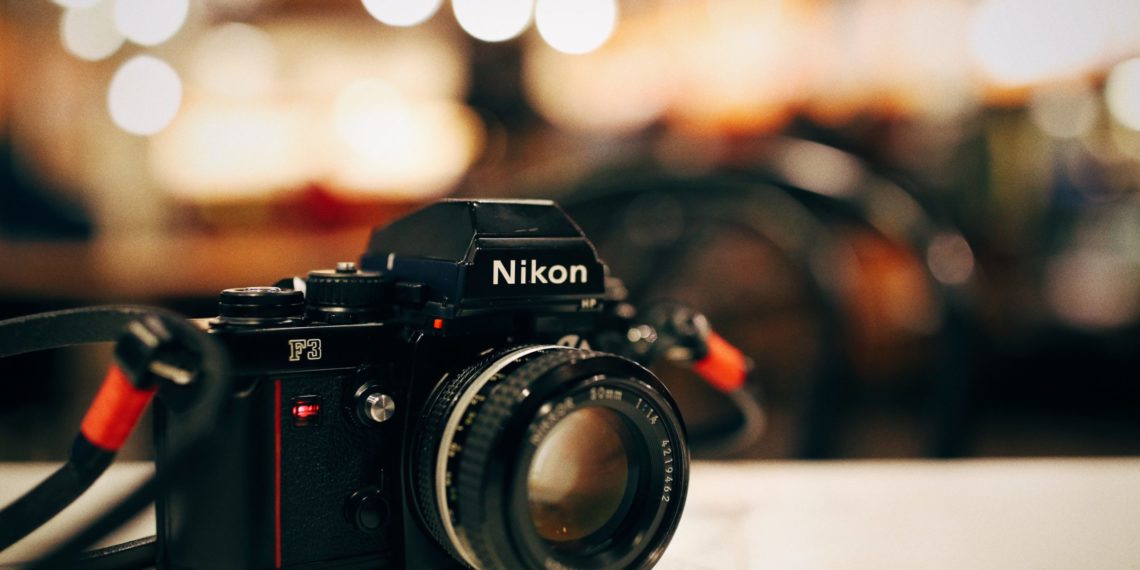



Discussion about this post